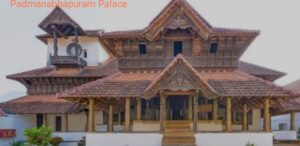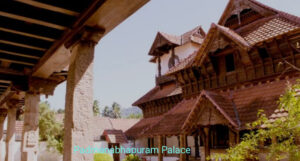When it comes to exploring the cultural and architectural heritage of India, Kerala often stands out for its rich history and stunning landmarks. Among the many treasures of this southern state, Padmanabhapuram Palace holds a special place. Nestled in the quaint town of Padmanabhapuram in Tamil Nadu, though geographically within Tamil Nadu, it is historically and culturally significant to Kerala. This palace is a magnificent example of traditional Kerala architecture and stands as a testament to the region’s glorious past. Whether you’re a history buff, an architecture enthusiast, or simply someone who appreciates beauty, Padmanabhapuram Palace is a must-visit destination.

1.Historical Background of Padmanabhapuram Palace
The origins of Padmanabhapuram Palace can be traced back to the 16th century. It was initially constructed by Iravi Varma Kulasekhara Perumal in 1601 AD, a king of the Travancore dynasty. However, it was under the reign of King Marthanda Varma, who ascended the throne in 1729, that the palace gained prominence. He renovated and expanded the palace, making it the administrative and cultural center of the powerful Travancore kingdom.
King Marthanda Varma dedicated the kingdom to Lord Padmanabha (a form of Lord Vishnu) and ruled as the deity’s servant, a tradition that continued with his successors. The palace, with its intricate woodwork, murals, and sprawling courtyards, reflects the prosperity and artistic sensibilities of the era. Even after the capital moved to Trivandrum (now Thiruvananthapuram), Padmanabhapuram Palace continued to be a symbol of the Travancore dynasty’s grandeur.
2.Architectural Marvels of Padmanabhapuram Palace
Padmanabhapuram Palace is an architectural gem, showcasing a unique blend of traditional Kerala style with influences from other regions. The palace is primarily constructed from locally sourced materials, including teakwood, rosewood, and granite, which give it a distinct and elegant appearance. The craftsmanship evident in the intricate wood carvings, detailed mural paintings, and the overall layout of the palace is nothing short of spectacular.
One of the most striking features of the palace is its traditional Kerala architecture, characterized by sloping roofs, intricate wooden beams, and large courtyards. The palace is designed to stay cool even during the scorching summer months, a testament to the eco-friendly and sustainable architectural practices of the time. The natural materials used in construction, coupled with the strategic design, create a harmonious blend with the surrounding environment.
The palace also features a stunning array of murals, some of which are over 300 years old. These murals depict scenes from Hindu mythology, everyday life, and the grandeur of the royal court, offering visitors a glimpse into the cultural and religious life of the time. Another architectural marvel is the clock tower, which houses a 300-year-old clock that still keeps time – a true testament to the engineering prowess of the period.
3.Key Attractions Within the Palace
Visiting Padmanabhapuram Palace is like stepping back in time. The palace complex is vast, covering an area of approximately 6.5 acres, and includes several sections, each with its own unique charm and significance. Here are some of the key attractions within the palace:
– Mantra sala (Council Chamber): This is arguably the most ornate room in the palace, where the king held discussions with his ministers. The room is adorned with elaborate wood carvings and is known for its natural cooling system, which keeps it cool even during the hottest months.
– The Thai Kottaram (Mother’s Palace):The oldest part of the palace, the Thai Kottaram, is built in the traditional Nalukettu style, with a central courtyard open to the sky. This section of the palace has a simple yet elegant design, reflecting the architectural practices of early Kerala.
– The Nataka sala (Performance Hall): This hall was used for cultural performances and gatherings. It features a raised platform for performers and is adorned with intricate woodwork and carvings. The hall’s acoustics are superb, making it a perfect venue for traditional music and dance performances.
– The King’s Chamber: This section of the palace offers a glimpse into the luxurious lifestyle of the Travancore royals. The chamber is richly decorated with ornate furniture, including a beautifully carved bed made from a combination of 64 different medicinal woods, believed to have healing properties.
– The Clock Tower: As mentioned earlier, the palace’s clock tower houses a 300-year-old clock that still functions. This ancient timepiece is a marvel of engineering and adds to the palace’s historical charm.
– Museum and Artifacts: The palace also includes a small museum that displays a fascinating collection of artifacts, including ancient weapons, household items, and paintings. These items provide insights into the daily life and culture of the Travancore era.

4.Cultural Significance and Preservation
Padmanabhapuram Palace is not just an architectural wonder; it is also a symbol of Kerala’s rich cultural heritage. The palace reflects the socio-political and cultural life of the time, offering valuable insights into the history of the region. It stands as a testament to the artistic and engineering achievements of the Travancore dynasty.
Over the years, significant efforts have been made to preserve and maintain the palace. The Archaeological Survey of India (ASI) has undertaken extensive restoration work to ensure that this historical monument remains intact for future generations. The palace is also listed as a tentative UNESCO World Heritage site, highlighting its global significance and the need for its preservation.
5.Visitor Information
Padmanabhapuram Palace is located about 65 kilometers from Thiruvananthapuram, Kerala, and is easily accessible by road. The nearest railway station is Nagercoil, and the nearest airport is Trivandrum International Airport. The palace is open to visitors from 9:00 AM to 5:00 PM, with a break for lunch between 1:00 PM and 1:30 PM.
There is a nominal entry fee for visitors, with guided tours available for those who wish to learn more about the history and architecture of the palace. It’s advisable to wear comfortable clothing and shoes, as you’ll be walking quite a bit. Photography is allowed in most parts of the palace, but certain areas may have restrictions.
If you’re planning a visit, consider exploring nearby attractions such as the serene Padmanabhapuram Beach, the vibrant markets of Nagercoil, and the historic Thiruvattar Adikesava Perumal Temple.
Conclusion:
Padmanabhapuram Palace is a true gem of Kerala’s cultural and architectural heritage. Its timeless beauty, rich history, and intricate craftsmanship make it a must-visit destination for anyone interested in exploring India’s royal past. Whether you’re a local resident or a traveler from afar, visiting Padmanabhapuram Palace offers a unique opportunity to step back in time and experience the grandeur of the Travancore dynasty. Don’t miss the chance to explore this magnificent palace and immerse yourself in the rich history and culture of Kerala.
FAQ:
1.What is special about Padmanabhapuram Palace?
2.Which movie is filmed in Padmanabhapuram Palace?
3.What is the entry fee for Padmanabhapuram Palace?
4.Padmanabhapuram Palace location
5.Padmanabhapuram palace distance
6.Padmanabhapuram Palace architecture details
7.Padmanabhapuram Palace to Trivandrum
8.Kanyakumari to Padmanabhapuram Palace distance
9.Who built Padmanabhapuram Palace

